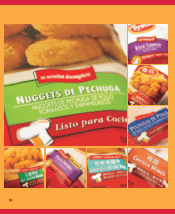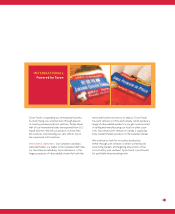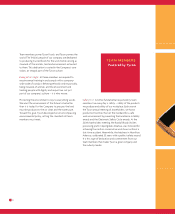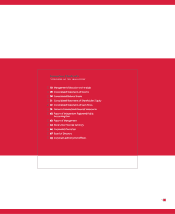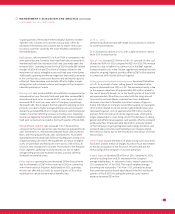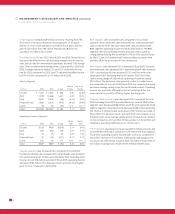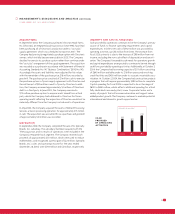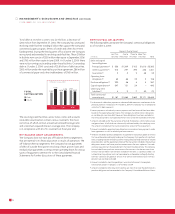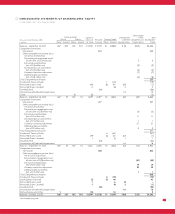Tyson Foods 2004 Annual Report Download - page 23
Download and view the complete annual report
Please find page 23 of the 2004 Tyson Foods annual report below. You can navigate through the pages in the report by either clicking on the pages listed below, or by using the keyword search tool below to find specific information within the annual report.
21
MANAGEMENT’S DISCUSSION AND ANALYSIS (CONTINUED)
to grain purchases. The increase in the Company’s domestic Chicken
segment sales volumes in fiscal 2004 was partially offset by
decreased international sales volumes due to import restrictions
by various countries caused by the avian influenza outbreaks in
the United States.
sales increased 0.1% in fiscal 2004 as compared to the
same period last year. Domestic fresh meat beef sales increased 6.0%,
international beef sales decreased 31.6% and case-ready beef sales
increased 18.0%. Operating income for fiscal 2004 includes BSE-related
charges of $61 million and $5 million of charges related to the
impairment of various intangible assets and fixed asset write-downs.
Additionally, operating income was negatively impacted by increases
in live cattle prices, production declines and decreased capacity
utilization. These decreases were partially offset by higher average
selling prices and increased volumes and margins at the Company’s
Lakeside operation in Canada.
sales increased 28.9% in fiscal 2004 as compared to the
same period last year. Domestic fresh meat pork sales increased 26.1%,
international pork sales increased 60.2%, case-ready pork sales
increased 29.4% and live swine sales of Company owned hogs
decreased 14.8%. The increase in the Pork segment’s operating income
primarily was due to higher average selling prices and increased
demand as pork benefited from stronger domestic and international
markets, more than offsetting increases in live hog costs. Operating
income was negatively impacted by approximately $1 million related to
fixed asset write-downs recorded in the fourth quarter of fiscal 2004.
sales increased 7.3% in fiscal 2004 as
compared to the same period last year. Foodservice prepared foods
sales increased 13.2%, international prepared foods sales increased
16.0% and retail prepared foods sales increased 0.5%. Fiscal 2004
operating income increased $25 million, excluding plant closing costs
of approximately $27 million, the impairment of various intangible
assets of $22 million and fixed asset write-downs of $5 million, all
of which were recorded in fiscal 2004. The increase in the Prepared
Foods segment’s operating income primarily was due to higher
average selling prices and increased volumes, partially offset by
increased raw material prices.
operating income decreased $145 million primarily
due to settlements of $167 million received in 2003 in connection
with vitamin antitrust litigation. Additionally in 2003, operating
income was affected positively by actuarial gains of $13 million
resulting from certain retiree medical benefit plans.
Certain reclassifications have been made to prior periods to conform
to current presentations.
increased $1.2 billion or 5.1%, with a slight increase in volume
and a 5.0% increase in price.
increased $1.3 billion or 5.8%. As a percent of sales, cost
of sales was 92.9% for 2003 compared to 92.2% for 2002. This increase
primarily is due to higher live cattle prices in the Beef segment,
increases in grain costs in the Chicken segment and increased accruals
related to on-going litigation, partially offset by $167 million received
in connection with vitamin antitrust litigation.
decreased $46 million
or 5.4%. As a percent of sales, selling, general and administrative
expenses decreased from 3.8% to 3.4%. The decrease primarily is due
to the expense reductions of approximately $42 million related to
the sale of Specialty Brands, Inc. in the fourth quarter of fiscal 2002,
and approximately $16 million associated with the integration of
Tyson and Tyson Fresh Meats corporate functions. Additional
decreases were due to favorable investment returns of approxi-
mately $18 million on Company owned life insurance, actuarial gains
of $13 million related to certain retiree medical benefit plans and
decreased litigation costs of approximately $19 million resulting
primarily from the reversal of certain legal accruals which are no
longer required due to cases being closed. The decreases in selling,
general and administrative expenses were partially offset by increased
professional fees of approximately $26 million, primarily related
to the Company’s on-going integration and strategic initiatives, and
increased sales promotions and marketing costs of approximately
$45 million, primarily due to the introduction and rollout of several
new products.
include $76 million of plant closing costs incurred in
fiscal 2003, and $53 million of charges incurred in fiscal 2002 related
to the discontinuation of the Thomas E. Wilson brand and the
restructuring of the Company’s live swine operations.
decreased $9 million or 2.8% compared to 2002,
primarily resulting from an 8.2% decrease in the Company’s
average indebtedness. As a percent of sales, interest expense was
1.2% compared to 1.3% for 2002. The overall weighted average
borrowing rate increased to 7.4% from 7.0%, primarily resulting
from premiums paid on bonds repurchased in the first and fourth
quarters of fiscal 2003. Excluding the premiums paid, interest
expense decreased $21 million.



